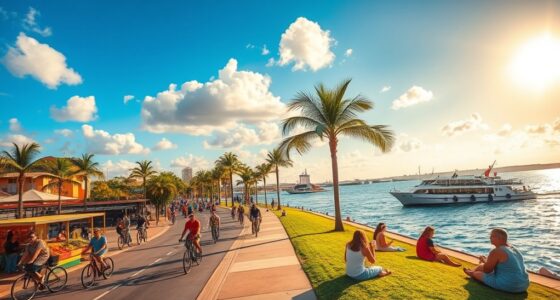Explore Melbourne’s sustainable neighborhoods to experience vibrant community-driven initiatives, lush green spaces, and innovative renewable energy solutions. Check out the Royal Botanic Gardens for relaxation and stroll through farmers’ markets for organic produce. Use the extensive tram network to easily navigate the city and engage with local businesses promoting eco-friendliness. By embracing these sustainable practices, you’ll connect with your community and contribute to the city’s healthier future. Discover more opportunities to get involved in Melbourne’s sustainability movement!
Key Takeaways
- Explore the Royal Botanic Gardens and Fitzroy Gardens for a blend of greenery and urban relaxation within Melbourne’s sustainable neighborhoods.
- Visit neighborhoods with solar panel initiatives, where schools and homes prioritize renewable energy for a cleaner environment.
- Experience vibrant local farmers’ markets that promote organic produce and eco-friendly shopping, supporting the community’s sustainable practices.
- Discover areas with extensive tram and train networks, encouraging car-free movement and emphasizing walkability for an eco-friendly lifestyle.
- Engage with community-driven projects that foster local connections and environmental responsibility, enhancing Melbourne’s commitment to sustainability.

Melbourne is leading the way in creating sustainable neighborhoods that prioritize environmental health and community well-being. As you explore this vibrant city, you’ll discover how local initiatives focus on integrating urban green spaces and renewable energy solutions into daily life. These efforts not only enhance the beauty of the city but also foster a sense of community and belonging among residents.
Imagine strolling through the many parks and gardens scattered throughout Melbourne. You’ll find urban green spaces like the Royal Botanic Gardens and Fitzroy Gardens, which offer lush greenery and a refuge from the hustle and bustle of city life. These parks serve as essential lungs for the urban environment, improving air quality and providing habitats for local wildlife. You can relax on a bench, take a leisurely walk, or participate in community events, all while being surrounded by nature. It’s a great way to connect with your neighbors and enjoy the benefits of outdoor activities.
In addition to these green spaces, Melbourne’s commitment to renewable energy initiatives is transforming the way the city powers itself. You might come across solar panels adorning rooftops in various neighborhoods, showcasing the city’s dedication to harnessing clean energy. Local schools, community centers, and even private homes are increasingly adopting solar technology, which considerably reduces their carbon footprint. You’ll feel proud knowing that by choosing to live in Melbourne, you’re contributing to a cleaner, more sustainable future.
As you navigate through these sustainable neighborhoods, you’ll notice how urban planning emphasizes walkability and public transport. Melbourne’s extensive tram and train networks make it easy to get around without relying on cars. This not only cuts down greenhouse gas emissions but also encourages you to explore more of the city on foot. You can enjoy the charming streets, unique architecture, and vibrant street art while getting some exercise.
The community spirit in Melbourne is palpable. Local farmers’ markets and eco-friendly shops are abundant, allowing you to support local businesses and sustainable practices. You might find organic produce, handmade goods, and even workshops on sustainable living. Engaging with these community-focused initiatives helps you build connections and deepen your understanding of the importance of sustainability.
In Melbourne, you’re not just experiencing a city; you’re participating in a movement. By embracing urban green spaces and renewable energy initiatives, you’re contributing to a healthier, more sustainable future for all.
Frequently Asked Questions
What Defines a Sustainable Neighborhood in Melbourne?
A sustainable neighborhood in Melbourne is defined by its commitment to urban green spaces and renewable energy initiatives. You’ll notice parks and gardens that promote biodiversity, encouraging community interaction and enhancing air quality. Additionally, many neighborhoods focus on using renewable energy sources like solar panels, reducing carbon footprints. These elements not only create a healthier environment but also foster a sense of community, making the area vibrant and livable for everyone involved.
How Can I Get Involved in Local Sustainability Initiatives?
You can get involved in local sustainability initiatives by joining community gardens in your area. These gardens not only promote local food production but also foster connections among neighbors. Additionally, look for organizations that focus on renewable energy projects; volunteering with them can help you learn and advocate for clean energy solutions. Attend local workshops or meetings to stay informed and find out how you can contribute to making your community more sustainable.
Are There Eco-Friendly Accommodations in These Neighborhoods?
They say, “Home is where the heart is,” and you’ll find plenty of eco-friendly lodging in Melbourne’s neighborhoods. Many places offer green accommodation options, featuring sustainable practices like solar energy and water conservation. Check out boutique hotels or B&Bs committed to minimizing their environmental impact. By choosing these accommodations, you’ll not only enjoy a unique stay but also support local sustainability efforts. So, pack your bags and get ready for a green getaway!
What Transportation Options Are Available for Exploring Sustainable Areas?
You’ve got some great transportation options for exploring sustainable areas. Electric bikes are a fun and eco-friendly way to get around, allowing you to easily navigate the neighborhoods while enjoying the scenery. If you prefer public transit, Melbourne’s extensive tram and train system makes it simple to reach various eco-friendly hotspots. Both options let you reduce your carbon footprint while discovering all the sustainable gems the city has to offer.
How Can I Support Local Businesses in Sustainable Neighborhoods?
You can be the heartbeat of your community by supporting local artisans and promoting green markets. Immerse yourself in the vibrant tapestry of handcrafted goods and fresh produce, where each purchase echoes your commitment to sustainability. Attend local events, spread the word about your favorite shops, and choose to shop small over big-box stores. Your choices can weave a stronger fabric of support, nurturing the very roots of sustainable neighborhoods and cultivating a thriving local economy.
Conclusion
As you explore Melbourne’s sustainable neighborhoods, you’ll discover innovative practices that make a real difference. Did you know that over 40% of Melbourne’s residents live within a 20-minute walk of essential services? This accessibility not only promotes healthier lifestyles but also fosters a strong sense of community. So, grab your walking shoes and immerse yourself in the vibrant, eco-friendly neighborhoods that showcase how sustainability and urban living can go hand in hand.










